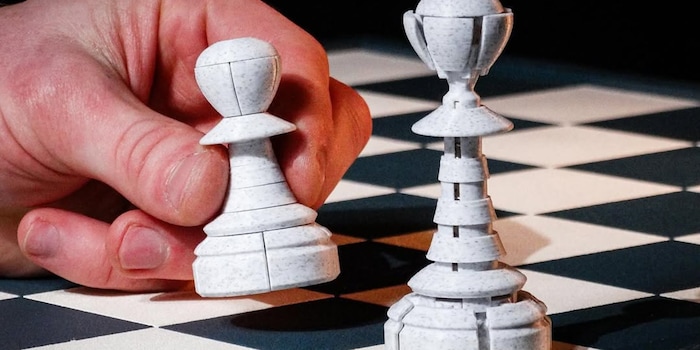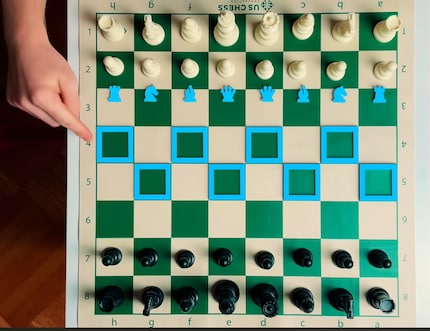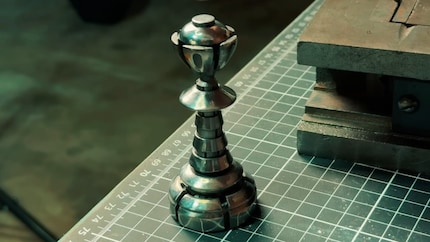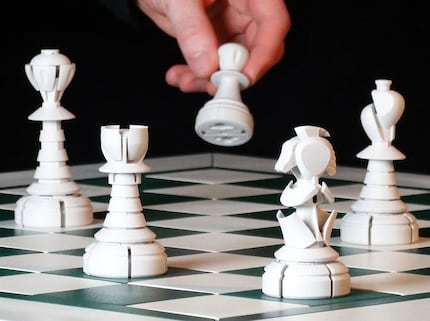
How a YouTuber brings movement to the game of chess
A YouTuber uses 3D printing, springs and magnets to add a new dimension to the game of chess. His pieces transform independently on the board.
YouTuber «Works by Design» has realised an unusual project: chess pieces that transform themselves. Using 3D printing and a cleverly designed mechanism, he automatically transforms pawns into higher-value pieces such as queens, rooks, bishops or knights. The result is a fascinating mix of technology, design and classic play.
From digital design to physical piece
The idea is as simple as it is ingenious: a pawn that transforms not just symbolically, but visibly. «Works by Design» translates the classic pawn transformation - which in chess takes place on the opponent's base line - into a mechanical form.
On his specially prepared board, this does not happen at the end of the board, but on a marked line «» in the centre area. When the pawn reaches one of these squares, a magnet in the base activates the built-in mechanism. In this way, «Works by Design» deliberately shifts the rules of the game.

Source: Works by Design / YouTube
To do this, Works by Design created models in the CAD programme in which tiny hinges, springs and magnets interact precisely. After printing on an FDM 3D printer, the parts can be assembled into a functioning system without any post-processing.
As soon as the trigger is released, the figure opens: hidden elements unfold and the farmer takes on a new shape. The principle is reminiscent of Miniature Transformers - only on the scale of a board game.
Four pieces, one mechanism
«Works by Design» began with a pawn that could automatically transform into a queen. He has since expanded the principle considerably: his new models make it possible to transform the pawn into all four possible pieces - queen, rook, bishop or knight - using interchangeable modules. He shows the concept in detail in his video «Building pawns that transform into every piece».
In addition, he published the 3D print files for all variants on Patreon, including a modular chessboard that reliably triggers the transformation mechanism.
The Community reacted enthusiastically: on Reddit and in hobbyist forums, the project is considered a prime example of «mechanical elegance in 3D printing». The precise construction and lack of support material are particularly praised.
When mechanics change the game
The exciting thing is how the concept affects the game itself. In classic chess, the pawn conversion remains a mental moment - the player replaces the piece and the game continues. «Works by Design» makes this moment visible and audible. When the pawn suddenly unfolds on the board and transforms into a new piece, a physical, almost theatrical moment is created.
At the end of his concept video, the YouTuber shows the pieces for the first time in public at the Mechanics' Institute Chess Club in San Francisco, one of the oldest chess clubs in the USA. The audience reacted with visible enthusiasm, some laughed, others filmed. Many seemed surprised at how much a purely mechanical movement can change the familiar feel of the game. For seconds, the focus shifts: the strategic move becomes a minor spectacle.
But the change goes further than just the show and also has playful consequences. If a pawn can transform itself into a new piece in the centre of the board, this fundamentally changes the strategy. Pawns become active danger points that opponents can no longer ignore. Attacks develop more quickly, defences have to be planned earlier - every move towards the transformation line harbours both risk and opportunity.

Source: Works by Design / YouTube
On the sidelines of the presentation, Works by Design also showed a special version of his figure: a pawn made from 3D-printed metal parts. He donated the unique piece to the club as a souvenir.
Two variants for the start of the game
Works by Design also talks about possible starting line-ups in his video. He shows two variants of how his figures can be brought into play.
In the first variant, the player can freely distribute the pawns on the board - in other words, decide for themselves which pawn goes where. Because each pawn is firmly linked to a specific piece, it can only transform into exactly this piece later on. This creates a strategic element even before the first move: a pawn that can transform into a queen is more suitable in the centre, while a knight pawn on the edge can be more tactically interesting.

Source: Works by Design / Instagram
In the second variant, the pawns are placed in fixed positions based on the classic piece order. Each pawn is placed in front of the piece it can later transform into - i.e. the queen pawn in front of the queen, the knight pawn in front of the knight, the bishop pawn in front of the bishop and so on. This keeps the game closer to the classic structure, but adds a new level of tension: you know right from the start what potential lies in which line.
Both approaches noticeably change the game of chess. The pawns are no longer just simple pawns, but carry the promise of transformation from the outset and therefore a degree of uncertainty that characterises each game anew.
My interests are varied, I just like to enjoy life. Always on the lookout for news about darts, gaming, films and series.
From the latest iPhone to the return of 80s fashion. The editorial team will help you make sense of it all.
Show all